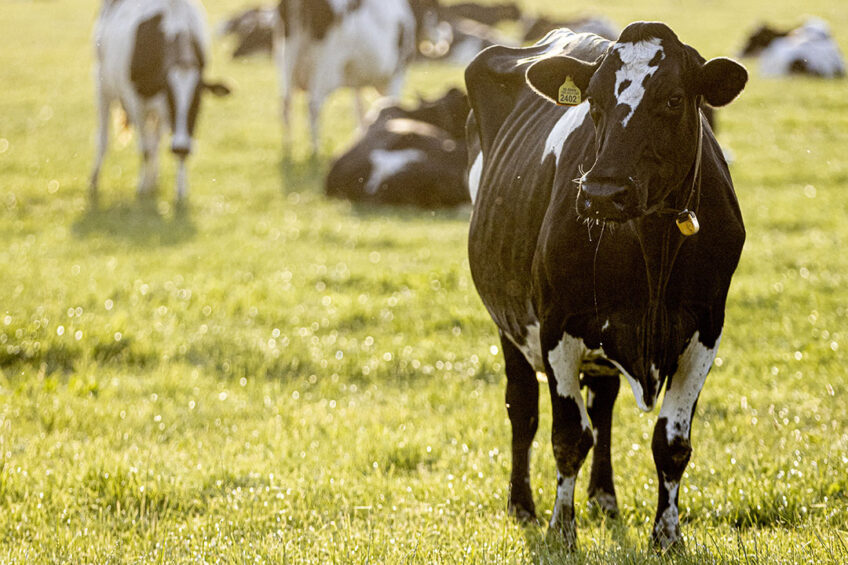Nutritional strategies to reduce nitrogen emissions from dairy production

Nutrition plays an important role in reducing emissions. This article contains an overview of possible nutritional strategies that could help reduce nitrogen emissions from dairy production systems.
A growing world population constantly increases the demand for meat and milk, thus, enhancing the environmental pollution concerns associated with intensive dairy farming. Dairy cattle are the main agricultural source of greenhouse gases such as carbon dioxide, methane, nitrous oxide and ammonia worldwide.
Emission of nitrous oxide and ammonia from dairy production systems disrupts environmental sustainability, reduces growth performance and decreases the quality of milk and meat from dairy cattle.
One of the factors promoting nitrogen emission from dairy production systems is the ineffective use of feed nitrogen, leading to waste and environmental pollution. Dairy cattle’s ability to use feed nitrogen is associated with feed ingredients and the composition and structure of the rumen microbiota. This is why practising effective nutritional strategies reduces nitrogen emissions from dairy production systems.
Nitrogen metabolism by rumen microbiota
Proteolytic and peptidolytic bacteria in dairy cattle’s rumens break dietary proteins and peptides down into amino acids and eventually deaminate them into ammonia or incorporate them into microbial proteins. When the amount of feed protein in the rumen exceeds the amount required by the rumen microbiota, ammonia is produced from the feed protein and excreted.
Why are nutritional strategies effective?
Dairy cattle adjust their nutrient intake and metabolism based on their physiological hunger and appetite. As a result, modification of basic ingredients and active substances in the diet enhances nitrogen metabolism and related growth performance, which in turn results in large nitrous oxide and ammonia emissions and environmental pollution. Thus, application of nutritional strategies to improve nitrogen is critical to mend nitrogen metabolism and to reduce emissions. These nutritional strategies are discussed in the next section.
Examples of plants and essential oils that reduce emissions
Supplementation with tamarind residue silage in feed reduces faecal nitrogen excretion and increases nitrogen retention.
Andrographis paniculata and sainfoin (onobrychis viciifolia) decrease ruminal ammonia concentration and improve nutrient digestibility and ruminal protein synthesis.
A mixture of nigella sativa seeds and rosmarinus officinalis leaves reduces ammonia in the rumen and increases weight gain.
Feeding sunflower oil improves urea-nitrogen recycling and microbial non-ammonia nitrogen supply, reduces urinary nitrogen excretion and ammonia concentrations, and increases nitrogen retention.
Garlic leaf prevents amino acid and protein degradation, enhances nitrogen metabolism and body weight gain by improving the microbial nitrogen supply.
Crude glycerin and soybean meal improve the microbial protein yield and nitrogen retention of the rumen and reduce nitrogen emissions.
Saponins, essential oils, vanillin, zataria multiflora oil, clove oil, origanum oil, phenolic diterpenes and rosmarinus officinalis leaves reduce the abundance of ammoniagenic and proteolytic bacteria, protect proteins from degradation, improve nitrogen use efficiency, increase rumen fermentative capacity, and reduce the level of ammonia in the rumen.
Red clover – or red clover silage – increases the proportion of ruminal undegraded dietary crude protein and reduces the amount of amino acid, urinary nitrogen excretion, and ammonia concentrations in the rumen.
Antimicrobial peptides improve the structure of rumen microbiota, increase feed utilisation efficiency, and reduce ammonia concentration in the rumen.
Tannin complex proteins to reduce nitrogen excretion
Tannins are a class of astringent, polyphenolic biomolecules that bind to proteins and amino acids, increase pH and the abundance of nitrogen metabolism-related microbiota in the rumen, augment nutrient digestibility, improve nitrogen retention, and reduce nitrogen emission. Tannin complex proteins, which are insoluble in the rumen, protect proteins from microbial enzymes, reduce protein degradation, increase the efficiency of microbial protein synthesis, reduce the ammonia level, and enhance the flow of non-ammonia nitrogenous compounds into the gut, thus reducing nitrogen excretion.
The importance of dietary crude protein
Excessive dietary crude protein and amino acid imbalance lead to protein resource wastage and nitrogen pollution. Decreasing dietary protein increases nitrogen retention, reduces nitrogen emission, enhances milk nitrogen efficiency, and reduces urinary nitrogen excretion in late-lactation cows.
Feeding a diet with a low level of crude protein improves the recovery of microbial protein in the rumen, reduces excessive nitrogen emission under the influence of urea recycling without negative effects on protein synthesis.
Supplementing specific amino acids, slow-release urea and calcium hydroxide-treated rice straw alters nitrogen metabolism and nitrogen utilisation efficiency, improves the ammonia-nitrogen and urea conversion and the availability of carbon skeletons, increases the microbial protein synthesis and production of ruminal volatile fatty acids, and nitrogen retention, and reduces the concentrations of ammonia in the rumen and plasma urea. In addition, adjusting the ratio of crude protein and starch improves nitrogen retention and emission.
Feed treatment could impact nitrogen metabolism
Feed treatment including cutting time, maturity stage of forage, and feeding mode impact nitrogen metabolism in dairy cattle. Feeding alfalfa hay in the early growth period and cutting it in the afternoon can reduce faecal nitrogen concentrations and increase the efficiency of feed nitrogen utilisation due to its higher non-structural carbohydrate content. Italian ryegrass is an efficient forage to take up and recycle urinary nitrogen. Feeding fresh forage rape and dicyandiamide reduces excreted and urinary nitrogen levels. In addition, protein infusion into the abomasum instead of the rumen improves the efficiency of nitrogen utilisation and excretion due to different regulation of nitrogen metabolism in various supplementation sites.
Concluding remarks
Global livestock production is estimated to contribute 14.5% to total greenhouse gas emissions, with dairy production systems being responsible for about 30% of these emissions. Due to the large contribution of dairy production systems to climate change, nutritional strategies are required to mitigate greenhouse emissions. Plants and essential oils, tannin complex proteins, dietary crude proteins, and feed treatment are effective approaches that can be used to improve nitrogen retention and reduce nitrogen emission. However, further research is required to find the appropriate concentrations and combinations of feed additives to regulate nitrogen metabolism in dairy cattle.
This article is based on the publication: ‘Amino acids metabolism by rumen microorganisms: Nutrition and ecology strategies to reduce nitrogen emissions from the inside to the outside’. Published in Science of The Total Environment Volume 800, 15 December 2021.







